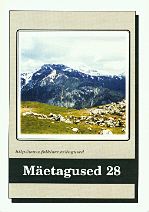Asustuspildist muinasaegsel Järvamaal - asustuskeskused ja linnused
Settlements in the prehistoric Järva County - centres and hill-forts
Author(s): Priit LättiSubject(s): Archaeology
Published by: Eesti Kirjandusmuuseum
Summary/Abstract: One of the main aims of this paper is to take a look at possible settlement centres in five parishes of the Järva County in Central Estonia which may have formed the central regions of the county in prehistory. Currently known hill forts are also considered as possible centres of settlement, and an attempt has been made to determine their sphere of influence and connection with the settlement. So far, little is known about the prehistory and archaeological sites of the Järva County. Also, not much is known about the ancient administrative division of the county. In the book about prehistory in Estonia (Eesti esiajalugu) and in articles about the prehistory of the Järva County (Vassar 1972; Tõnisson 1999; Lätti 2004a), it has been assumed that the county was divided into three ancient parishes. The author of this study attempts to test the aforementioned assumption on the evidence of archaeological sites. Relying on information about archaeological sites it is possible to single out settlement centres in the parishes of Ambla, Järva-Jaani, Peetri and Järva-Madise. The only exception is the Koeru parish where archaeological sites are located evenly throughout the parish with no specific condensed area. The speculated division of the Järva County into three prehistoric parishes appears to be founded mostly on environmental conditions. Some apparent centres, however, do not seem to date back to the Iron Age, or are located in the periphery of a parish. The village of Reinevere, for example, which is located near the border of the Ambla parish, i.e. in the periphery, could not have been a likely centre of a prehistoric parish. The location of another centre in Järva-Jaani parish is questionable, owing to the fact that no Iron Age sites have been found in Järva-Jaani. Rather, the actual centre might have been in the village of Kuksema only 2 km away, or Jalgsema village with its Iron Age archaeological sites. At the same time, the location of the church seems to favour Kuksema or Järva-Jaani, because the construction of church far from the parish centre is not very likely. Thus, the exact location of the centre of the prehistoric Järva-Jaani parish is very hard to determine. The centre of the third ancient parish, Kareda, is a large area dating back to Iron Age; hence, a very likely centre. Of the known hill-forts of the Järva County, the most typical is that of Jäneda in Ambla parish; other hill-forts are smaller in size and, probably, display no defensive constructions. The hill-forts of Jäneda, Villismägi, Siimumägi in the Järva-Jaani parish and Kaalepi hill-fort in the Järva-Madise parish are located relatively close to an Iron Age settlement; others, which are located mostly far from the settlements, could have functioned as shelters. As most of hill-forts have no defensive constructions, it is possible that they were economic rather than military centres. However, its possible categorisation into a hill-fort cannot be ruled out either.
Journal: Mäetagused. Hüperajakiri
- Issue Year: 2005
- Issue No: 28
- Page Range: 123-148
- Page Count: 26
- Language: Estonian

